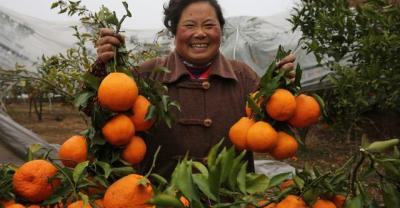Problems and Countermeasures of Citrus planting
In 2016, the planting area of citrus in China reached 2.5567 million hm and the total output was 36.168 million tons, which grew rapidly in the western producing areas such as Guangxi, Chongqing, Sichuan and Yunnan, and remained stable in the central regions such as Hunan, Hubei and Jiangxi. Among them, Jiangxi and other provinces suffered from extreme low temperature freezing injury and Huanglong disease. The eastern producing areas, mainly in Zhejiang, Fujian and Guangdong provinces, continued to shrink by 3,200 hm;, which widened the gap with the central and western regions, and the citrus industry shifted to the west obviously.
At the same time, in citrus cultivation in China, there are some problems, such as high production cost and labor shortage, which seriously restrict the development of citrus planting industry. Corresponding countermeasures should be formulated and measures such as optimizing variety structure and large-scale planting should be taken to ensure the sustainable development of citrus industry.
1 problems existing in citrus planting
1.1 small acreage
At present, the main characteristic of citrus cultivation in China is dispersion, and the orange orchards of most fruit growers are contracted by households in the past. On the one hand, the planting area is relatively small, on the other hand, the planting technology is not high, with the reduction of citrus sales prices. Economic benefits showed a downward trend. At present, many Chinese growers plant with the attitude of compensation for land expropriation, and some orange orchards with convenient transportation have always adopted extensive management, making it difficult for many agricultural enterprises or citrus professional cooperatives to expand their planting area, adding difficulty to the large-scale operation of citrus [1].
1.2 High production cost and low sales price
In the process of citrus planting, except for the costs of fertilizers, pesticides and employees, the net profit of citrus is not high. At the same time, due to the rising prices of agricultural labor and agricultural materials in recent years, while the sales price of citrus is relatively low for a long time, the cost is increasing and the economic benefit is decreasing, which affects the development of citrus planting industry.
1.3 there is no scientific ecological cultivation technology plan.
In the existing citrus planting industry, it has not formed a large scale, and extensive management is mostly used in production, which directly affects the improvement of the quality and scale of citrus planting. At the same time, due to the lack of scientific and reasonable cultivation techniques to guide, resulting in fertilization, weeding, drought and other conservation techniques have not been done, affecting the improvement of citrus yield.
1.4 lack of mastery of citrus twig pruning techniques
Citrus twig pruning technology is a pruning method that removes the overdense branches in the middle and upper parts of the crown that affect the light, opens the crown, makes the crown concave and convex, and makes it ventilated and transparent, but in recent years, due to labor shortage and high cost, the production cost has increased year by year. Lack of proficiency in citrus pruning technology and lack of scientific guidance affect the progress and development of citrus pruning technology. Hinder the increase of citrus production [2-3].
2 countermeasures
2.1 Construction of standard orchards and development of efficient orange orchards
Strengthen the construction of the standard orchard, build a large-scale citrus production base into a standard orchard, carry out unified management, and use advanced production management technology to improve the competitiveness of the citrus industry. In the construction of standard orchards, in order to promote the further promotion of citrus planting industry, transportation and other infrastructure construction should be strengthened. At the same time, government departments should optimize project funds and carry out overall planning to promote the development of citrus planting industry.
2.2 accelerate variety improvement and optimize planting structure
In the existing citrus production pattern, according to local conditions, select suitable areas to plant high-quality citrus varieties, optimize citrus planting structure, and give full play to the regional characteristics of citrus cultivation. The new late-maturing varieties, such as fertile mandarin, tango and so on, will continue to expand the scale of late-maturing varieties, further promote the scale of early and late citrus, adjust the structure of early, middle and late-maturing varieties to 25 ∶ 35 ∶ 40, the structure has been further optimized, the problem of difficult to sell mid-maturing varieties has been basically solved, and the benefit has been improved.
2.3 formulate a scientific and reasonable ecological cultivation technical plan for improving quality and increasing efficiency
According to the planting conditions of citrus, scientific and reasonable cultivation techniques were formulated, and the techniques of fertilization, weeding, drought resistance, pruning, fruit protection and pest control were allocated reasonably according to the changes of seasons. At the same time, the monthly working calendar of ecological cultivation techniques for improving quality and efficiency was established, and the monthly measures such as soil management and fertilization, comprehensive prevention and control of diseases and insect pests, tree and fruit management were recorded in detail to ensure the planting quality of citrus.
2.4 master the technique of pruning big branches of citrus
Citrus big branch pruning technology can transform the original tree shape into a natural happy crown, improve inner chamber lighting conditions, promote bore fruit, regulate tree growth, distribute nutrients reasonably, improve yield and quality, pay attention to spring pruning, young tree pruning can be postponed to budding stage, crown spacing between pruned trees should be no less than 20 cm, and row spacing should have a certain spacing. The height of the crown is controlled between 3.0 and 3.5 m, the tree is dwarfed and the crown opens [4].
The pruning technology of citrus big branches is a key technology of labor-saving cultivation of citrus. In the process of pruning, it must be noted that if there are too many main branches and secondary main branches, it can be pruned in 2 ~ 3 years, and the amount of pruning should be determined according to the actual situation of vegetation. When sawing a big branch, it is generally necessary to cut off or cut off the base of the big branch, do not leave the pile head, and reduce the hair of the new tip. After the big branches are pruned, the new shoots should be cut off in time to prevent the formation of long branches. After pruning, a series of measures, such as soil fertilizer and water management, flower and fruit protection, and pest control, should be taken to ensure that "big branch pruning" achieves the desired goal.
2.5 pay attention to the use of pesticides
It is forbidden to use methamidophos, methyl isosaliphate, internal phosphorus absorption, carbofuran, aldicarb, aldicarb, thiocyclophos and chlorazophos in fruit trees, and to prohibit the application of omethoate and isocarbophos in citrus. Highly toxic and highly toxic pesticides shall not be used to control sanitary pests, nor can they be used in vegetables, melons and fruits, tea and traditional Chinese medicine. According to the regulations on the Administration of pesticides, no pesticide products shall be used beyond the scope approved by pesticide registration [5].
Author: Xiang Jinsong. Modern agricultural science and technology



- Prev

Control techniques of Diseases and insect pests in Ginger planting
Ginger in the planting process will encounter a variety of different diseases and insect pests, how to better control diseases and insect pests, improve the yield of ginger, increase the income of farmers.
- Next

Rural project, dragon fruit planting know-how
The dragon fruit is a climbing succulent plant, the fruit is oblong or oval, the skin is red, fleshy, with egg-shaped and apical sharp scales, the flesh inside is like.
Related
- Fuxing push coffee new agricultural production and marketing class: lack of small-scale processing plants
- Jujube rice field leisure farm deep ploughing Yilan for five years to create a space for organic food and play
- Nongyu Farm-A trial of organic papaya for brave women with advanced technology
- Four points for attention in the prevention and control of diseases and insect pests of edible fungi
- How to add nutrient solution to Edible Fungi
- Is there any good way to control edible fungus mites?
- Open Inoculation Technology of Edible Fungi
- Is there any clever way to use fertilizer for edible fungus in winter?
- What agents are used to kill the pathogens of edible fungi in the mushroom shed?
- Rapid drying of Edible Fungi

